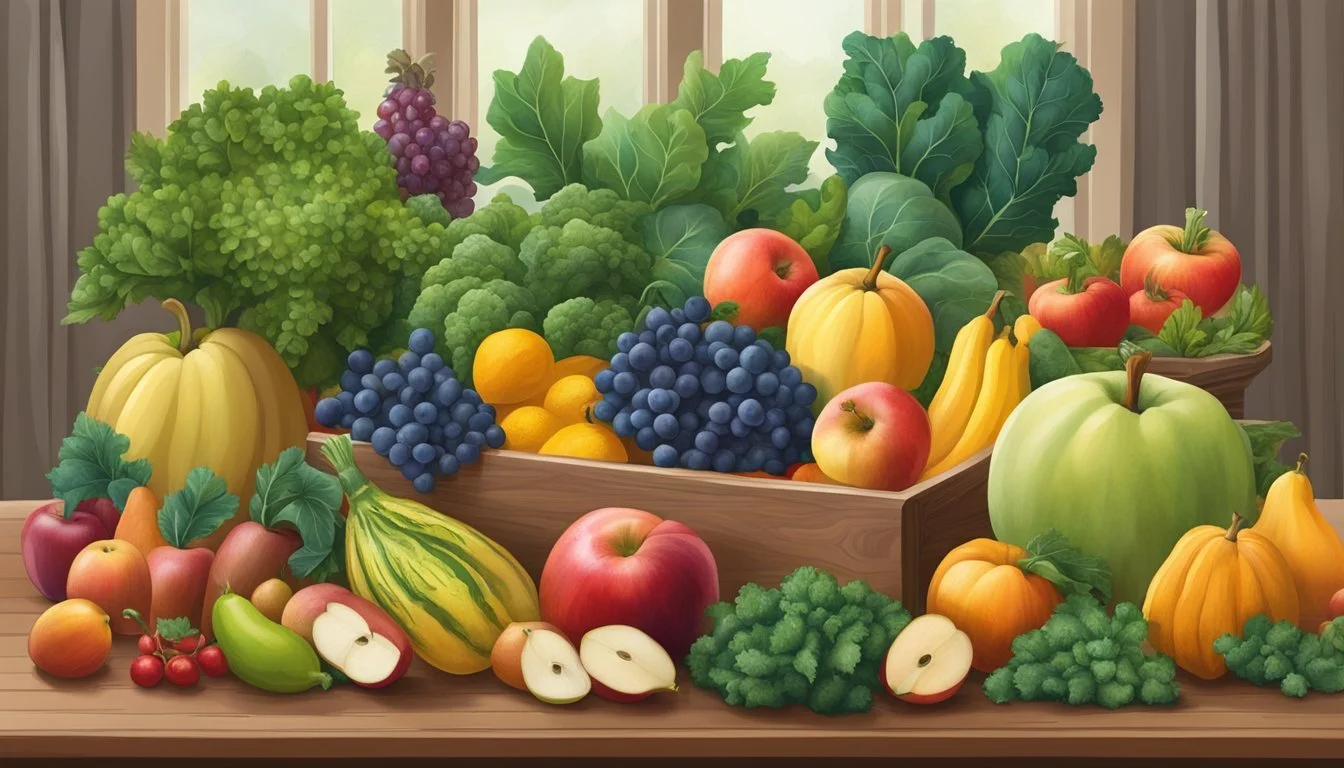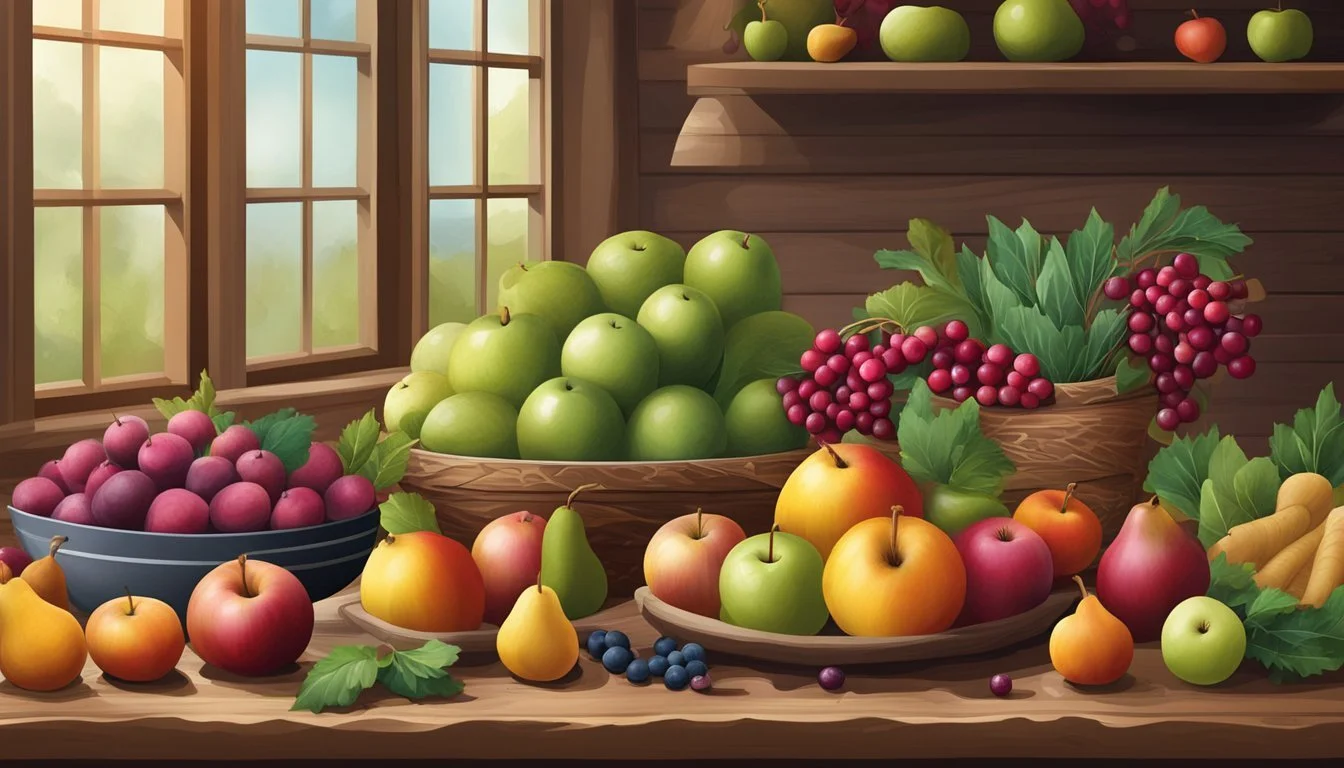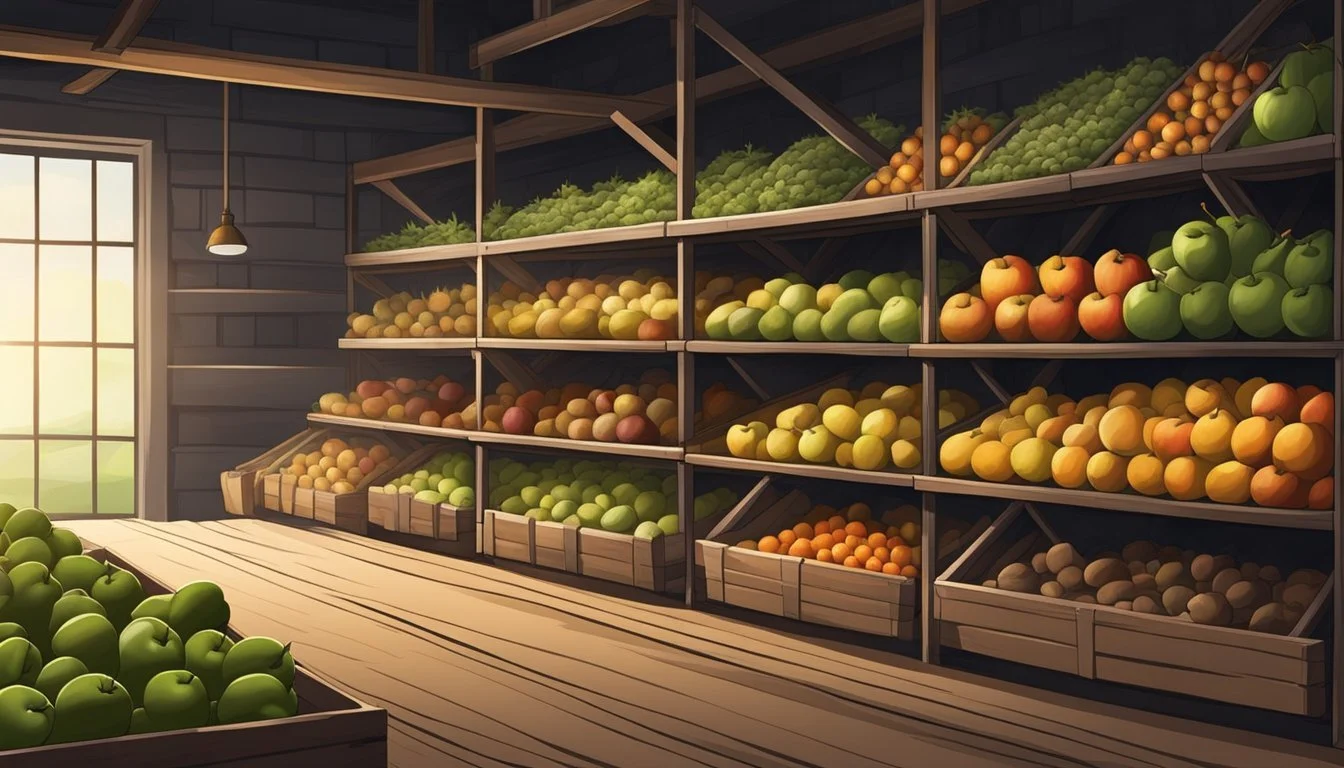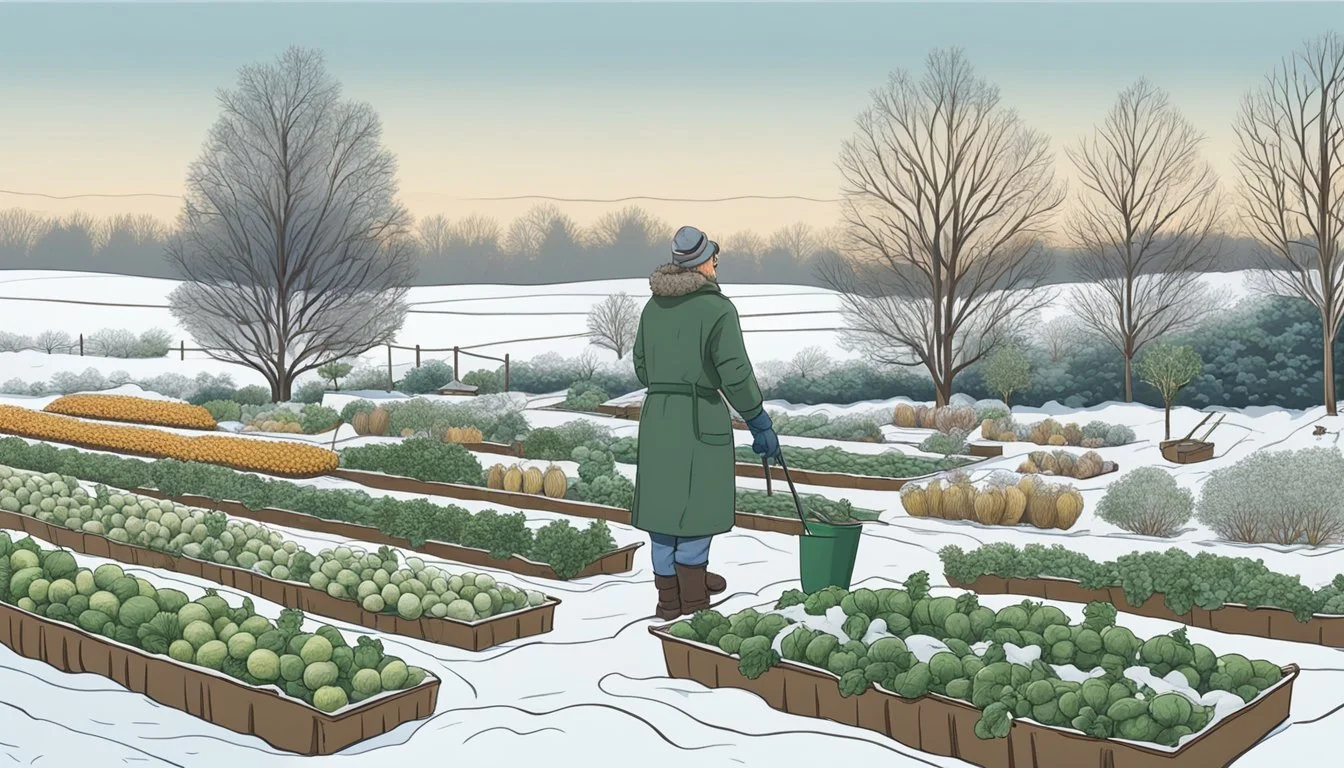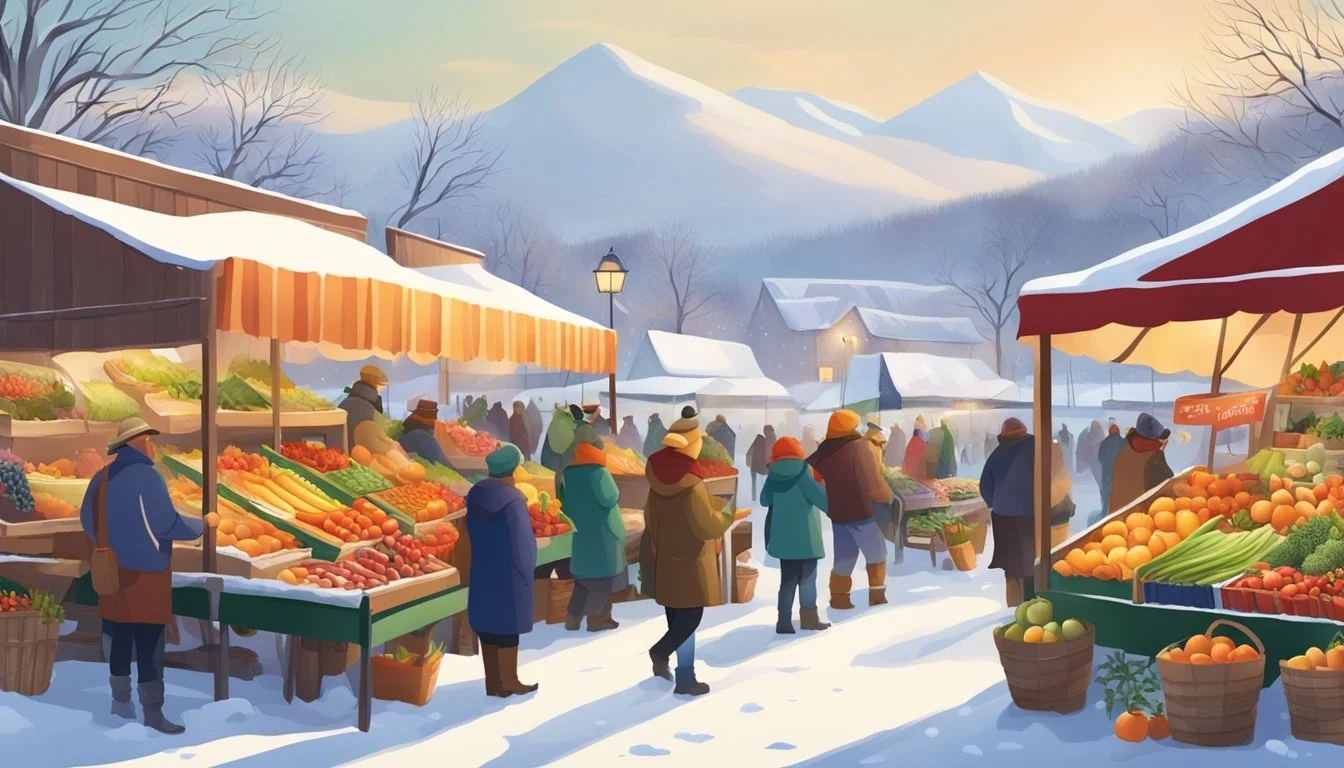Indiana Seasonal Fruit & Vegetables in December
A Guide to Fresh Produce Shopping
This Article is Part of our Indiana Seasonal Fruit & Veg Calendar
In Indiana, December marks a time of colder weather and a shift in available produce. During this month, residents and chefs alike turn toward the state's seasonal offerings to create dishes that are not only fresh but also a testament to the region's agricultural heritage. Despite the chill, Indiana's fields and orchards yield a variety of fruits and vegetables that are at their peak during the final month of the year.
Seasonal produce in December includes root vegetables and hearty greens, which are capable of withstanding the frosty temperatures. Root crops like turnips, parsnips, and sweet potatoes (What wine goes well with sweet potatoes?) are harvested and brought to market, offering texture and depth to winter meals. Greens such as kale, spinach, and collards thrive in the cold, becoming sweeter after a frost, and provide essential nutrients during a season when fresh local produce is more limited.
While fresh fruit options may be diminished in the winter months, some hardy varieties remain available. Apples and pears stored from earlier harvests continue to feature prominently in Indiana's December produce selection. Greenhouses also contribute to the variety, allowing for the cultivation of certain produce items that would otherwise not endure the winter climate, ensuring that consumers have access to a broader selection of fresh vegetables even as the year winds down.
Understanding Seasonal Produce in Indiana
When discussing Indiana’s seasonal produce for December, it's paramount to consider the impact of climate and local farming practices on the availability of fresh produce.
The Importance of Seasonality
Seasonality is crucial in guiding consumers towards fresh, locally-grown fruits and vegetables. In Indiana, this means selecting produce that is harvested at its peak for flavor, nutritional value, and sustainability. Seasonal eating supports local Indiana farmers markets, where one can find an abundance of fresh products that have been cultivated within the region’s growing conditions. These practices bolster the local economy and reduce the carbon footprint associated with long-distance food transport.
December's Agricultural Landscape
December’s cooler climate in Indiana narrows the range of available local produce. Farmers markets during this time typically offer winter-hardy vegetables. While the array of seasonal fruits is limited, one can prioritize vegetables like Brussels sprouts, cabbage, and carrots, which are often harvested in the late months of fall and can be stored into winter. These vegetables sustain their freshness and nutritional value when kept in proper storage conditions. Consumers seeking seasonal freshness can rely on these items for quality and taste that are characteristic of Indiana's winter agriculture.
Decembers Harvest: What to Expect
In December, Indiana's harvest brings a limited but hearty selection of fruits and vegetables, well-suited to the colder weather. Root vegetables and orchard fruits dominate this month's produce, offering a mix of sweet and earthy flavors for seasonal dishes.
Typical Fruits Available
Apples: A variety of apples are typically harvested in the fall and remain available through December. Expect crisp textures and a range from tart to sweet flavors.
Pears: Like apples, pears are a common fruit during this time, offering a soft, buttery texture and a subtly sweet taste.
Cranberries: Though less commonly grown in Indiana, cranberries harvested earlier in the fall may still be found in markets.
Oranges and Clementines: These citrus fruits are not grown in Indiana but are often available as imported produce, providing a burst of sweetness and vitamin C.
Typical Vegetables Available
Cabbage: Cabbage is a versatile vegetable that withstands the cooler temperatures and can be found fresh in December.
Kale: This leafy green is more flavorful after a frost, making it a staple in winter salads and hearty dishes.
Root Vegetables: A variety of root vegetables, including carrots and turnips, are usually available and are ideal for roasting or making stews.
Winter Squash: Varieties such as butternut or acorn squash are often still available from late fall harvests.
Sweet Potatoes: Known for their rich flavor and nutrition, sweet potatoes are another root vegetable common in December's harvest.
Sourcing Indiana Produce
In December, residents of Indiana can source fresh, in-season produce despite the cold, harnessing the vibrant offerings from local farmers markets and exploring various farming practices like organic and conventional methods.
Local Farmers Markets
Farmers markets provide a platform for consumers to purchase fresh produce directly from the growers, ensuring both quality and variety. In December, the Indy Winter Farmers Market serves as a vital source for locally-grown fruits and vegetables, even during the colder months. Shoppers at the market can find seasonal items that are often picked within days or even hours of the market, which can support local economy and reduce food miles.
List of Seasonal Produce Available at Indy Winter Farmers Market:
Root vegetables: carrots, parsnips
Winter greens: kale, collards
Squash varieties: acorn, butternut
Organic vs Conventional Options
When sourcing produce in Indiana, consumers often deliberate between organic and conventional options. Organic produce is grown without synthetic pesticides or fertilizers, and many shoppers seek it out for its environmental benefits and perceived health advantages. Conventional farming methods, on the other hand, may allow for larger yields and often come at a lower price point.
Comparison of Organic and Conventional Produce:
Aspect Organic Produce Conventional Produce Farming Practices No synthetic pesticides or fertilizers Utilizes synthetic pesticides and fertilizers Price Typically higher priced Generally more affordable Availability May be limited in winter months Often widely available
Shoppers can explore these options at farmers markets as well as at various markets throughout the state. It is important for consumers to make informed choices based on their personal preferences and the availability of produce during the winter season.
Health Benefits of Seasonal Eating
Seasonal eating in Indiana, during December particularly, focuses on consuming produce that is harvested at the peak of its supply. This practice can bolster nutrient intake and support immune function.
Nutritional Advantages
Seasonal vegetables such as kale, sweet potatoes, and cabbage are often richer in vitamins and minerals when harvested in season. For example:
Sweet Potatoes: A rich source of fiber and vitamins, including A and C.
Cabbage: Provides vitamin K and C, alongside fiber and other minerals.
Kale: Known for its density in nutrients, kale offers vitamins A, C, K, and numerous antioxidants.
These vegetables tend to be more flavorful as well, encouraging higher consumption and thus the intake of beneficial nutrients.
Supporting the Immune System During Winter
Consumption of seasonal produce like kale and sweet potatoes in December supplies the body with an array of immune-supporting nutrients.
Vitamin A: Crucial for maintaining healthy skin and mucous membranes, serving as the body's first line of defense.
Vitamin C: An essential nutrient known to support the immune system.
Fiber: Promotes a healthy digestive tract, which is vital for immune function.
By incorporating these seasonal vegetables into their diet, individuals can provide their bodies with necessary tools to ward off common winter ailments.
Culinary Inspirations for December Produce
Indiana's December produce provides ample opportunity for rich, comforting recipes against the chill of winter. Utilizing seasonal fruits and vegetables, one can create dishes ranging from heartwarming soups to festive holiday sides which not only taste delicious but also promote sustainability and local farming.
Hearty Recipes for Cold Days
In the cold month of December in Indiana, hearty recipes provide warmth and comfort. Soups and stews become staple dishes, often featuring seasonal produce such as kale and Brussels sprouts.
Soups: A robust kale soup, often with beans and hearty vegetables, can be both nutritious and filling.
Stews: Brussels sprouts can be included in beef stews, (What wine goes well with beef stew?) lending a slight nutty flavor and a pop of green.
Festive Dishes for the Holiday Seasons
The holidays inspire festive dishes that utilize the brightness of December fruits and the richness of its vegetables.
Salads: Citrus fruits like oranges and tangelos add a fresh zest to holiday salads.
Side Dishes: Mashed sweet potatoes become a savory side dish, often enhanced with a hint of cinnamon or nutmeg (how long does nutmeg last?).
Casseroles: Casseroles such as green bean or Brussels sprout gratin make an appearance, offering creamy and crunchy textures perfect for holiday enjoyment.
Preserving Methods for Seasonal Surplus
The seasonal surplus of produce can be preserved to extend enjoyment throughout the following months.
Sauces: One can cook down fruits into thick, rich sauces or compotes that pair well with desserts or as glazes for roasted meats (What wine goes well with roasted meats?).
Roast: Vegetables like broccoli and romanesco can be roasted with olive oil and herbs, then preserved through freezing or canning for later use.
Storage and Preservation Tips
Proper storage methods can significantly extend the shelf life of Indiana's seasonal fruits and vegetables in December. Focusing on root vegetables, apples, pears, cabbage, kale, and squash, this section outlines specific strategies to maintain freshness and provides practical home storage solutions.
Extending Freshness
Root Vegetables: Store unwashed root vegetables in a cool, dark, and humid environment. They can be kept in perforated plastic bags in the crisper drawer of a refrigerator or in a root cellar. Beets, radishes, and turnips generally last for weeks when stored properly.
Apples: Keep apples refrigerated in a plastic bag with holes to allow air circulation. They tend to absorb smells, so they should be stored away from strong-odored foods.
Pears: Similar to apples, pears should be stored in the refrigerator. They ripen at room temperature, so refrigerate them once they reach the desired ripeness.
Cabbage and Kale: Store these leafy greens in a refrigerator's crisper drawer, loosely wrapped in a damp paper towel then placed in an open plastic bag. Cabbage can last for several weeks, whereas kale should be consumed within a week for optimal freshness.
Squash: Winter squash varieties can be stored in a cool, dark place for months. Avoid refrigeration as the cold can cause squash to become mushy over time.
Home Storage Solutions
Root Vegetables: Use storage bins or even sand boxes in cellars or basements as an alternative to refrigeration, maintaining a temperature around 32°F to 40°F.
Apples and Pears: For bulk storage, apples and pears can be kept in wooden crates or cardboard boxes lined with straw to minimize bruising and allow air flow.
Cabbage and Kale: If lacking space in the refrigerator, consider using a cool basement or insulated garage that stays just above freezing for temporary storage of these vegetables.
Squash: Store on shelves or racks with enough space for air to circulate around each piece of squash, avoiding direct contact with walls to prevent rot.
Farm to Table: The Local Food Movement
In Indiana, December's chill does not dampen the commitment to farm-to-table initiatives. This movement is integral to supporting local economies and provides residents with fresh, locally-sourced produce.
Community-Supported Agriculture (CSA)
Community-Supported Agriculture, commonly known as CSA, is a key component of the local food movement in Indiana. Individuals can subscribe to the harvest of a specific farm or group of farms. By purchasing a CSA share, they receive regular deliveries of fresh seasonal produce. This system benefits local farmers by ensuring a stable market and income for their products while it offers community members access to the freshest possible food options.
Benefits of CSA:
For Consumers: Fresh, seasonal produce; direct connection to food source
For Farmers: Pre-season capital; guaranteed market
The Economic Impact of Supporting Local Producers
Purchasing from local producers at markets such as farmers markets, injects money directly into the Indiana economy. When individuals buy local, it creates a ripple effect: farmers spend money on local services and goods, which supports other local businesses. Consequently, supporting local producers encourages the resilience and growth of local economies.
Economic Benefits:
Money circulates within the community, bolstering economic health
Creates local jobs and supports the agricultural sector
Markets play a pivotal role in this economic cycle by offering platforms where local goods can be directly sold to consumers. The bond between community and farmer is strengthened through these interactions, fostering a sense of unity and shared purpose.
December Gardening Tips for Home Growers
As winter sets in, December in Indiana presents unique challenges and opportunities for home growers. With the right strategies, they can enjoy a productive season and set the stage for spring success.
Indoor Gardening
Lighting: With reduced daylight, it's crucial to provide indoor plants with sufficient light. Gardeners should invest in quality grow lights that mimic natural sunlight, positioning them for maximum exposure without overheating the plants.
Temperature and Humidity: Indoor plants typically thrive at temperatures around 65-75°F during the day and slightly cooler at night. A consistent humidity level is equally important, aiming for around 40-60%. Growers may use humidifiers or place water trays near the heat source to maintain these levels.
Watering and Feeding: Overwatering is a common mistake in winter. Gardeners should check the soil moisture and water only when necessary. A reduced feeding schedule is also advised since plants grow more slowly in winter.
Edible Plants: Indiana growers can cultivate a range of edible plants indoors, including herbs, microgreens, and salad leaves. The Indy Winter Farmers Market can be a source of inspiration and local varieties best suited for indoor growth.
Preparing for the Spring Planting
Plan: Home growers should begin planning their spring garden in December. They can research plant varieties and create a planting schedule, ordering seeds from reliable suppliers.
Equipment Maintenance: It's the right season to clean, sharpen, and repair gardening tools. Taking inventory of pots, soil conditioners, and other supplies helps in avoiding last-minute rushes.
Soil Preparation: If accessible, now is the time to test and amend the soil. Adding compost or other organic matter improves the soil structure and fertility for spring planting.
Structures and Protection: Structures like cold frames can protect overwintering plants. Growers should inspect and repair any existing structures and consider installing new ones if needed.
Guide: A handy guide or checklist tailored to Indiana's climate can be invaluable for planning the garden layout and ensuring that crop rotations and companion plantings are considered for the upcoming season.
Frequently Asked Questions
When shopping for fruits and vegetables in December in Indiana, consumers often have questions about how to choose the best produce and what certain labels mean. This section addresses those concerns with straightforward guidance for making informed choices.
Selecting Quality Produce
When selecting fresh produce, one should look for crisp textures and a sweet fragrance, especially when it comes to apples, pears, and root vegetables common in Indiana during December. For the best quality, consumers are recommended to:
Opt for produce that feels firm and heavy for its size.
Check for vibrant, consistent color as a sign of ripeness and flavor.
Avoid fruits and vegetables with bruises or blemishes.
Understanding Organic Labels
Organic labels can be confusing. Produce carrying the "USDA Organic" seal means they've been produced following federal guidelines addressing factors like soil quality, pest control, and use of additives. Organically grown produce implies:
No synthetic fertilizers or pesticides were used in its growing process.
They were produced using methods that promote ecological balance and conserve biodiversity.
Conclusion: Embracing Indiana's Winter Offerings
December in Indiana may not boast the vibrant array of fruits and vegetables found in the summer months, but it presents a unique variety of fresh, local produce that thrives in the winter season. Root vegetables take center stage during this time, showcasing the resilience and diversity of Indiana's agricultural strengths.
Root Vegetables: Local markets and community-supported agriculture programs typically highlight an assortment of root vegetables. These hardy staples store well and provide a nutritious foundation for winter meals.
Beets
Carrots
Parsnips
Turnips
Potatoes
Seasonal Greens: Despite the chill, some greens are in their prime during Indiana’s colder months, lending fresh flavors and nutrition to the winter table.
Collards
Spinach
Emphasizing these local offerings supports the community by nourishing ties between consumers, farmers, and regional food systems. It encourages sustainability and a deeper appreciation for the seasonal cycles that dictate the harvests. Shop at nearby farmers’ markets or join a winter CSA program to explore the array of local produce available during this season.
Consumers can enjoy the comfort of fresh, seasonal ingredients, knowing they are participating in a sustainable cycle that benefits both the environment and the local economy. By choosing to incorporate these winter offerings into daily meals, Indiana residents celebrate the season's unique palate and reinforce a tradition of community reliance on what is readily available and naturally suited to the regional climate.





